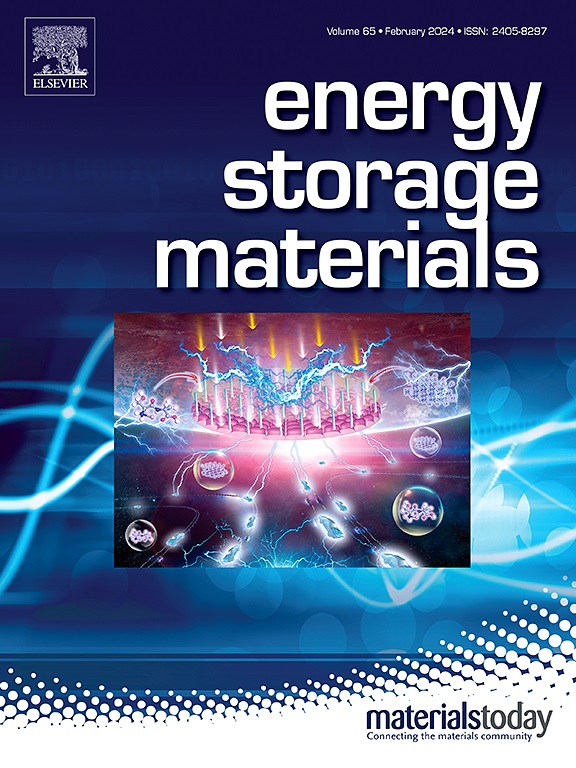Direct regeneration of highly degraded LiNi0.6Co0.2Mn0.2O2 to high-performance single-crystalline cathodes
IF 18.9
1区 材料科学
Q1 CHEMISTRY, PHYSICAL
引用次数: 0
Abstract
The widespread popularization of electric vehicles and portable electronics gives rise to the concomitant surge of spent lithium-ion batteries (LIBs). Considering the resource shortage and environmental concerns, recycling degraded cathode materials is highly desirable to ensure the sustainable development of the whole LIBs industry. To this end, a facile LiBr-LiOH eutectic molten salt strategy is proposed for direct regeneration of highly degraded polycrystalline LiNi0.6Co0.2Mn0.2O2 (denoted as D-NCM622), which enables efficient renovation of the nonstoichiometric composition and damaged crystal structure in D-NCM622, including full Li-supplement, complete restoration from rock salt/spinel phases to the original layered structure, suppressive cation disorder, and reconstructed single-crystalline nature. Benefiting from these favorable structural characteristics, the regenerated cathodes (R-NCM622) exhibit significantly enhanced electrochemical performance relative to D-NCM622, delivering an initial discharge capacity of 174.0 mAh g−1 at 0.2 C, capacity retention of 82.5% after 200 cycles at 0.5 C, and excellent rate performance (136.7 mAh g−1 at 5 C), which is comparable to the fresh commercial NCM622 (C-NCM622). More significantly, the current regeneration route possesses the incomparable advantages in economic benefit and environmental impact compared to conventional recycling routes based on techno-economic analysis, ensuring sustainable recycling from highly degraded cathode materials.

高降解LiNi0.6Co0.2Mn0.2O2直接再生成高性能单晶阴极
随着电动汽车和便携式电子产品的广泛普及,废旧锂离子电池(LIBs)也随之激增。考虑到资源短缺和环境问题,回收降解正极材料是确保整个锂离子电池行业可持续发展的迫切需要。为此,提出了一种简便的liba - lioh共晶熔盐策略,用于直接再生高度降解的多晶LiNi0.6Co0.2Mn0.2O2(表示为D-NCM622),该策略可以有效地修复D-NCM622中非化学组成和受损的晶体结构,包括充分补充li,从岩盐/尖晶石相完全恢复到原始的层状结构,抑制阳离子无序,重建单晶性质。得益于这些有利的结构特征,再生阴极(R-NCM622)相对于D-NCM622表现出显著增强的电化学性能,在0.2 C下提供174.0 mAh g−1的初始放电容量,在0.5 C下200次循环后的容量保持率为82.5%,在5 C下具有优异的倍率性能(136.7 mAh g−1),与新鲜的商用NCM622 (C-NCM622)相当。更重要的是,基于技术经济分析,目前的再生路线在经济效益和环境影响方面具有传统回收路线无法比拟的优势,确保了高降解正极材料的可持续回收。
本文章由计算机程序翻译,如有差异,请以英文原文为准。
求助全文
约1分钟内获得全文
求助全文
来源期刊

Energy Storage Materials
Materials Science-General Materials Science
CiteScore
33.00
自引率
5.90%
发文量
652
审稿时长
27 days
期刊介绍:
Energy Storage Materials is a global interdisciplinary journal dedicated to sharing scientific and technological advancements in materials and devices for advanced energy storage and related energy conversion, such as in metal-O2 batteries. The journal features comprehensive research articles, including full papers and short communications, as well as authoritative feature articles and reviews by leading experts in the field.
Energy Storage Materials covers a wide range of topics, including the synthesis, fabrication, structure, properties, performance, and technological applications of energy storage materials. Additionally, the journal explores strategies, policies, and developments in the field of energy storage materials and devices for sustainable energy.
Published papers are selected based on their scientific and technological significance, their ability to provide valuable new knowledge, and their relevance to the international research community.
 求助内容:
求助内容: 应助结果提醒方式:
应助结果提醒方式:


